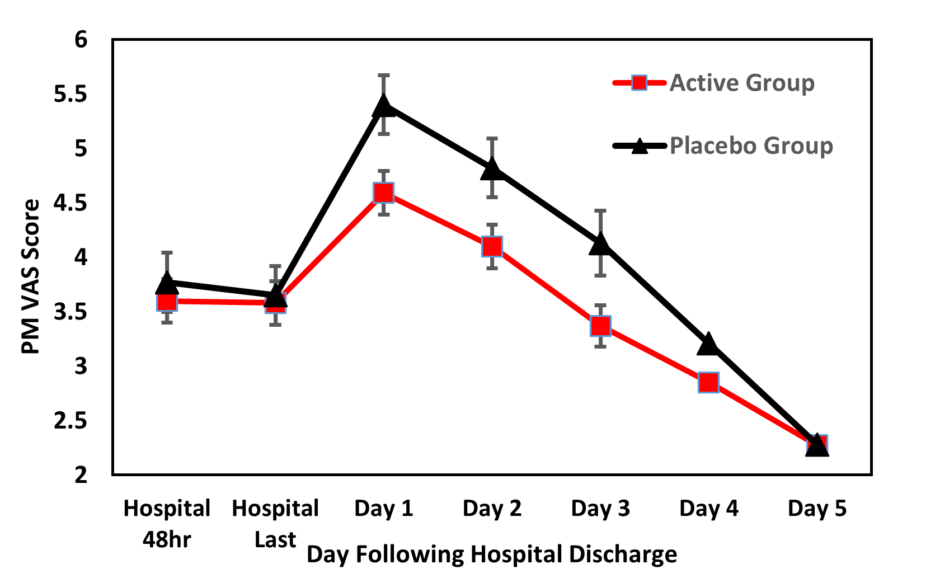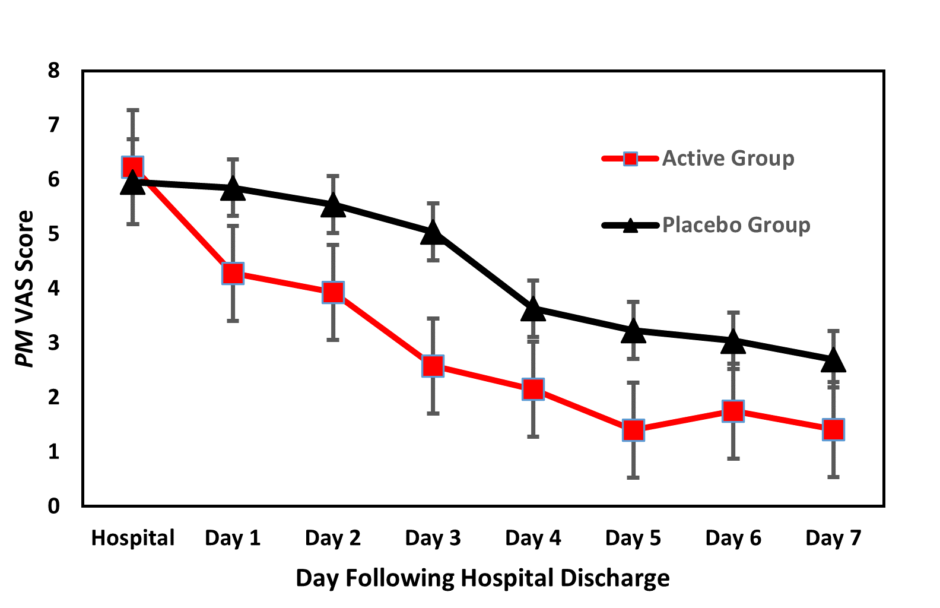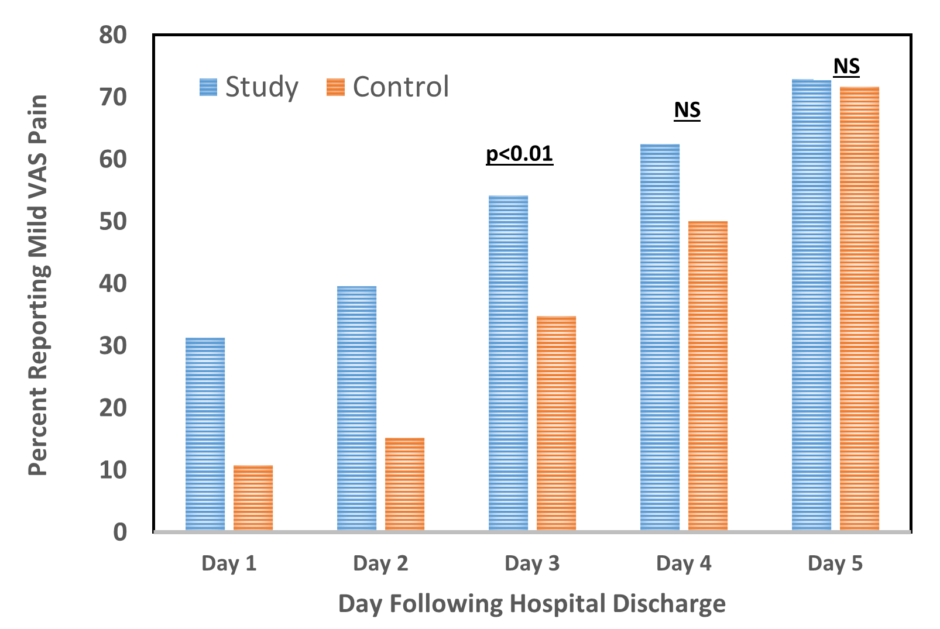RecoveryRx® Postoperative Clinical Studies
Postoperative Pain
Pulsed Electromagnetic Fields for Postsurgical Pain Management in Women Undergoing Cesarean Section A Randomized, Double-Blind, Placebo-controlled Trial
in Women Undergoing Cesarean Section A Randomized, Double-Blind, Placebo-controlled Trial
Maryam Khooshideh, MD,*Seyedeh Sakineh Latifi Rostami, MD, Mahdi Sheikh,MD,PhD,w Batool Ghorbani Yekta, MD, and Ali Shahriari, MD
To evaluate the efficacy of pulsed electromagnetic field(PEMF) in relation to reducing postoperative pain, analgesic use,and wound healing in patients undergoing Cesarean section(C-section).
Caesarean -Section Study Summary
A total of 94 subjects were equally randomized into the active and placebo treatment groups in this double blind study. The primary measures were daily pain levels and medication use. In hospital pain scores were found to be equivalent across the two groups and averaged about 3.5 VAS points due to the hospital’s medication protocol of keeping pain levels low. However, upon arriving home, pain levels in the placebo group increased significantly, with the average pain score about 2 VAS points higher than when they were in the hospital. While pain levels in the treatment group also increased upon arriving home, the average increase was significantly lower when compared to the placebo group.
These results are shown graphically in Figure 1.

Figure 1: While the PM VAS scores for both groups increased when compared to the last hospital score, the increase was lower in the active treatment group by 0.74 points.
A second analysis looked at the proportion of subjects who reported only mild pain (VAS<=3) during their total stay in the hospital and the proportion who reported mild pain for any given day (i.e., both AM and PM) during home recovery. During hospital stay, 27% in the active group and 10.8% in the placebo group reported a mild pain score for each of the pain scores recorded. This difference was significant at the p<0.05 level. The same analysis was conducted on data for subjects reporting mild VAS pain in the 5 days and is shown in Figure 2.
Figure 2: Percent reporting mild pain (VAS <=3) on both AM and PM VAS scores, during at-home period of postoperative recovery. A test for differences between two independent sample proportions indicates that the proportion of patients reporting “mild pain” differ significantly between active and placebo groups and days 1, 2 and 3, but not 4 and 5.
Medication use during hospital stay and home recovery periods was lower in the active treatment group when compared to the placebo group, but these differences were not statistically significant.
View A Second C-Section Study Here
Control of Postoperative Pain with a Wearable Continuously Operating Pulsed Radiofrequency Energy Device: A Preliminary Study
Ian M. Rawe, Adam Lowenstein, C. Raul Barcelo & David G. Genecov
BioElectronics RecoveryRx® was investigated in a double blind, randomized and placebo controlled study for postoperative pain and narcotic pain medication use following breast augmentation surgery. The primary emphasis of the study was to investigate the temporal trajectory of how post-surgery VAS scores (AM, PM) decreased after discharge, and if this trajectory differed significantly across the active treatment or placebo treatment groups. These results of this analysis can be visualized in Figure 1.

Figure 1: The Active group indicated lower average pain and a quicker reduction in pain
In addition, 70% of patients in the treatment group indicated their pain was mild (i.e., 3 VAS points or lower) by day 3. This level of pain relief was not obtained in the placebo group until day 7. Pain medication use also reflected these lower pain levels as shown in table 1.

Table 1. Narcotic pain medication use (total pills) was significantly lower in the group using RecoveryRx®
The study is published in the Aesthetics of Plastic Surgery.
View Complete Postoperative Clinical Studies
Postoperative Pain & Edema
Accelerated recovery of post-operative dental implant patients by means of pulsed shortwave (SWT) therapy: An Observational Study
Operti & Tealdo March 2014
The purpose of this white paper is to report on the experience and on the clinical outcome resulting from the use of a wearable electromagnetic device (RecoveryRx Therapy by BioElectronics Corp., Frederick, MD USA) in post-operative implant patients and to evaluate the efficacy in reducing edema, inflammation and pain immediately after dental implant surgery. The device is known to promote faster than normal healing process, anticipating masticatory function.
View Complete Observational White Paper
Postoperative Edema
Use of Radio-Frequency Pulsed Energy in the Control of Postoperative Reaction in Blepharoplasty
Frederick V. Nicolle, M. Chir., F.R.C.S. and Richard M. Bentall, F.R.C.S.
Development of BioElectronics medical devices was based on the pioneering basic and clinical research by Dr Richard Bentall. In an initial study Dr. Bentall looked at the effect of radiofrequency electromagnetic fields on postoperative edema from blepharoplasty (eyelid surgery). This pioneering study was published in the Aesthetics of Plastic Surgery.
Testimonials
“I use RecoveryRx™ on every facial procedure. It reduces my patients bruising and swelling by 50% following Blepharoplasty, Face Lifts, and Rhinoplasty. As a result of RecoveryRx, two weeks of standard surgical recovery has been reduced to 5-7 days.”
Laurie Casas MD, FACS
Northwestern University
Feinberg School of Medicine
Contact us today!
Have a question about the RecoveryRx® technology or products? Feel free to contact us at 1-866-757-2284 or recoveryrx@bielcorp.com. We are open Monday – Friday 9am-4pm EST.
Contact us!
